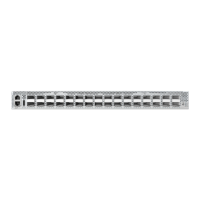C
HAPTER
15
| Multicast Filtering
Layer 3 IGMP (Query used with Multicast Routing)
– 412 –
The IGMP proxy routing tree must be manually configured by designating
one upstream interface and multiple downstream interfaces on each proxy
device. No other multicast routers except for the proxy devices can exist
within the tree, and the root of the tree must be connected to a wider
multicast infrastructure. Note that this protocol is limited to a single
administrative domain.
In more complicated scenarios where the topology is not a tree (such as
when there are diverse paths to multiple sources), a more robust failover
mechanism should be used. If more than one administrative domain is
involved, a multicast routing protocol should be used instead of IGMP
proxy.
To enable IGMP proxy service, follow these steps:
1. Enable IP multicasting globally on the router (see "Configuring Global
Settings for Multicast Routing" on page 544).
2. Enable IGMP on the downstream interfaces which require proxy
multicast service (see "Configuring IGMP Interface Parameters" on
page 413).
3. Enable IGMP proxy on the interface that is attached to an upstream
multicast router using the proxy settings described in this section.
4. Optional – Indicate how often the system will send unsolicited reports
to the upstream router using the Multicast > IGMP > Proxy page as
described later in this section.
COMMAND USAGE
◆ When IGMP proxy is enabled on an interface, that interface is known as
the upstream or host interface. This interface performs only the host
portion of IGMP by sending IGMP membership reports, and
automatically disables IGMP router functions.
◆ Interfaces with IGMP enabled, but not located in the direction of the
multicast tree root are known as downstream or router interfaces.
These interfaces perform the standard IGMP router functions by
maintaining a database of all IGMP subscriptions on the downstream
interface. IGMP must therefore be enabled on all interfaces which
require proxy multicast service.
◆ The system periodically checks the multicast route table for (*,G) any-
source multicast forwarding entries. When changes occur in the
downstream IGMP groups, an IGMP state change report is created and
sent to the upstream router.
◆ If there is an IGMPv1 or IGMPv2 querier on the upstream network, then
the proxy device will act as an IGMPv1 or IGMPv2 host on the upstream
interface accordingly, and set the v1/v2 query present timer to indicate
that there is an active v1/v2 querier in this VLAN. Otherwise, it will act
as an IGMPv3 host.

